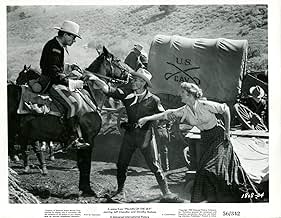IMDb RATING
6.2/10
793
YOUR RATING
In 1868 Oregon, after the Army violates the treaty by building a road across the reservation, several tribal chiefs decide to unite their forces against the trespassing whites.In 1868 Oregon, after the Army violates the treaty by building a road across the reservation, several tribal chiefs decide to unite their forces against the trespassing whites.In 1868 Oregon, after the Army violates the treaty by building a road across the reservation, several tribal chiefs decide to unite their forces against the trespassing whites.
- Director
- Writers
- All cast & crew
- Production, box office & more at IMDbPro
Storyline
Did you know
- TriviaBetween takes, Ward Bond argued with Lee Marvin that the US should attack the Soviet Union because of what Bond claimed to be the Communist threat. Marvin, an ex-Marine who served in World War II, was wounded in the fighting on Saipan against the Japanese,. He asked Bond--who had never spent a day in the military due to epilepsy, --how he spent the war. Bond had no real reply, and Marvin pointed out that the only thing Bond knew about war was what he pretended to fight on studio back lots.
- GoofsThe cavalry had a Red Cross wagon. The American Red Cross was not founded until 1881.
- ConnectionsFeatured in Cuba (1979)
- SoundtracksBugle Calls
(uncredited)
Composer unknown
Featured review
Near the Oregon Trail in what is now southeastern Washington and northeastern Oregon, tribal leaders are upset by the movements of a new cavalry officer and his troops, which break the treaty. An established First Sergeant whom the Indians trust (Chandler) tries to keep the peace, but war is inevitable. Lee Marvin is on hand as a young sergeant while Michael Ansara plays a hostile chief.
"Pillars of the Sky" (1956) came in the tradition of John Ford's Cavalry Trilogy from 1948-1950 and the ensuing "Warpath," as well "The Last Frontier" (aka "Savage Wilderness"). While it's arguably just as worthwhile as the Cavalry Trilogy in its own unique way, it's not as compelling as the other two.
Some of the key actors playing American Indians are Lebanese, Latino, Tennessean, and a New Yorker, but one is a Kickapoo and there are some other genuine Indian peripherals. Overall, their depiction is well done. Meanwhile Chandler's character is supposed to be an alcoholic, but he doesn't look or act like a typical functioning alcoholic, such as Ulysses S. Grant. Actually, Jeff is towering and god-like as the commanding noncommissioned officer, despite his drinking.
There's a love triangle thrown into the mix involving Chandler, Dorothy Malone and Keith Andes. While this might cause some eye-rolling, I'm pretty sure there were one or two love triangles during the decades of the Indian Wars. Speaking of rolling your eyes, there's some lame (and incongruous) comedy involving a raw recruit and his horse, but it's so minor it can be overlooked.
The best thing about this Western is the superb authentic locations and the muscular action. But I also liked the emphasis on Christianity with Ward Bond playing the missionary-physician. You'd never see this today, of course, as it's a great sin now to show Christianity in a positive light. Get real.
It runs 1 hour, 26 minutes (the version I watched), and was shot in northeast Oregon at Joseph and nearby Wallowa Lake, as well as LaGrande, which is to the west of there. Studio scenes were done at Universal Studios in the Los Angeles area.
GRADE: B-
"Pillars of the Sky" (1956) came in the tradition of John Ford's Cavalry Trilogy from 1948-1950 and the ensuing "Warpath," as well "The Last Frontier" (aka "Savage Wilderness"). While it's arguably just as worthwhile as the Cavalry Trilogy in its own unique way, it's not as compelling as the other two.
Some of the key actors playing American Indians are Lebanese, Latino, Tennessean, and a New Yorker, but one is a Kickapoo and there are some other genuine Indian peripherals. Overall, their depiction is well done. Meanwhile Chandler's character is supposed to be an alcoholic, but he doesn't look or act like a typical functioning alcoholic, such as Ulysses S. Grant. Actually, Jeff is towering and god-like as the commanding noncommissioned officer, despite his drinking.
There's a love triangle thrown into the mix involving Chandler, Dorothy Malone and Keith Andes. While this might cause some eye-rolling, I'm pretty sure there were one or two love triangles during the decades of the Indian Wars. Speaking of rolling your eyes, there's some lame (and incongruous) comedy involving a raw recruit and his horse, but it's so minor it can be overlooked.
The best thing about this Western is the superb authentic locations and the muscular action. But I also liked the emphasis on Christianity with Ward Bond playing the missionary-physician. You'd never see this today, of course, as it's a great sin now to show Christianity in a positive light. Get real.
It runs 1 hour, 26 minutes (the version I watched), and was shot in northeast Oregon at Joseph and nearby Wallowa Lake, as well as LaGrande, which is to the west of there. Studio scenes were done at Universal Studios in the Los Angeles area.
GRADE: B-
Details
Box office
- Gross US & Canada
- $1,500,000
- Runtime1 hour 35 minutes
- Color
- Aspect ratio
- 2.35 : 1
Contribute to this page
Suggest an edit or add missing content

Top Gap
By what name was The Tomahawk and the Cross (1956) officially released in India in English?
Answer




































